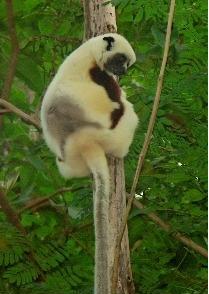Strepsirrhini facts for kids
Quick facts for kids StrepsirrhiniTemporal range: Early Eocene - Recent
|
|
|---|---|
 |
|
| Coquerel's Sifaka (Propithecus verreauxi) | |
| Scientific classification | |
| Kingdom: | |
| Phylum: | |
| Class: | |
| Order: | |
| Suborder: |
Strepsirrhini
E. Geoffroy, 1812
|
The Strepsirrhini clade is one of the two suborders of primates, with 114 species. They are defined by their wet noses, although the Greek name means having a curved or bent nose. Madagascar's only primates (apart from humans) are strepsirrhines, although others can be found in southeast Asia. Their eyes have a reflective layer to improve their night vision, and their eye sockets have a ring of bone around the eye. Strepsirrhine primates produce their own vitamin C, whereas haplorhine primates (and ourselves) must get it from their diets.
The suborder contains the lemurs and lorises. The modern types probably evolved from the Adapiforms, an extinct group.
The origin of the earliest primates, from which both the strepsirrhines and haplorhines (simians and tarsiers) evolved, is a mystery. Both their place of origin and the group from which they evolved are uncertain.
Although the fossil record of their initial radiation across the Northern Hemisphere is very detailed, the fossil record from the tropics—where primates most likely evolved—is very poor, particularly around the time that primates and other eutherian mammals were first appearing.
So, geneticists and primatologists have used genetic analyses to determine the relatedness between primate lines and when they diverged. Using this molecular clock, it seems that primates evolved more than 80–90 mya, nearly 40 million years before the first primates appear in the fossil record.p22
Classification
- Suborder Strepsirrhini: non-tarsier prosimians
- Infraorder Lemuriformes
- Superfamily Lemuroidea
- Family Cheirogaleidae: dwarf and mouse lemurs (32 species)
- Family Daubentoniidae: Aye-aye (1 species)
- Family Lemuridae: lemurs (22 species)
- Family Lepilemuridae: sportive lemurs (26 species)
- Family Indriidae: woolly lemurs and allies (19 species)
- Superfamily Lorisoidea
- Superfamily Lemuroidea
- Infraorder Lemuriformes
Images for kids
-
Early primates possessed adaptations for arboreal locomotion that enabled maneuvering along fine branches, as seen in this slender loris.
-
The suborder Strepsirrhini was proposed by É. Geoffroy in 1812.
-
The media attention over "Ida" played upon confused terminology and misconceptions about strepsirrhines.
-
Strepsirrhines are characterized by a typically longer snout and wet nose compared to haplorhine primates.
-
Strepsirrhines are threatened by deforestation in tropical regions.
See also
 In Spanish: Strepsirrhini para niños
In Spanish: Strepsirrhini para niños










